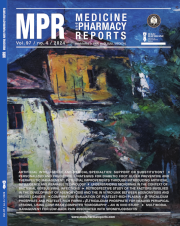5-Azacytidine treatment inhibits the development of lung cancer models via epigenetic reprogramming and activation of cellular pathways with anti-tumor activity
DOI:
https://doi.org/10.15386/mpr-2777Keywords:
NSCLC, epigenetic alterations, DNA methylation, cancer inhibitory effects, in vivo modelsAbstract
Background and aims. Non-small cell lung cancer (NSCLC) treatment is challenged by late detection and limited therapeutic options. Aberrant DNA methylation, a common epigenetic alteration in NSCLC, offers new therapeutic avenues. This study aims to evaluate the combined effects of 5-Azacytidine (5- Aza), an epigenetic modifier, and ionizing radiation (IR) on NSCLC, exploring the underlying molecular mechanisms and therapeutic potential.
Methods. In this study, we examined the effects of 5-Aza combined with IR in both in vitro and in vivo models of NSCLC. Five human NSCLC cell lines were treated with 5-Aza and IR. Cell viability, colony formation, wound healing, and transwell migration assays were performed to assess treatment effects. Microarray and qPCR analyses were conducted to identify gene expression changes. Additionally, subcutaneous and orthotopic xenograft models were used to evaluate the treatment’s efficacy in vivo.
Results. Treatment with 5-Aza and IR resulted in significant reductions in cell viability, colony formation, and migration in NSCLC cell lines. Microarray analysis revealed significant changes in gene expression, including the upregulation of apoptosis-related genes and the downregulation of cell proliferation-related genes. In vivo studies demonstrated a notable reduction in tumor growth and metastasis in both subcutaneous and orthotopic NSCLC models following 5-Aza and IR treatment. Histological and bioluminescent imaging confirmed the therapeutic effects of the combined treatment.
Conclusions. The combination of 5-Aza and IR shows promise as an effective treatment for NSCLC, enhancing apoptosis and reducing tumor growth through epigenetic modulation.
Downloads
Published
How to Cite
Issue
Section
License
The authors are required to transfer the copyright of the published paper to the journal. This is done by agreeing to sign the Copyright Assignment Form. Whenever the case, authors are also required to send permissions to reproduce material (such as illustrations) from the copyright holder.

The papers published in the journal are licensed under a Creative Commons Attribution-NonCommercial-NoDerivatives 4.0 International License.

